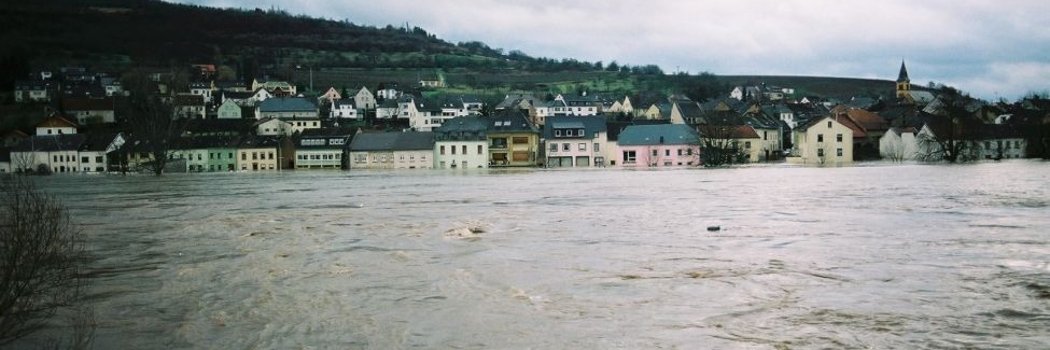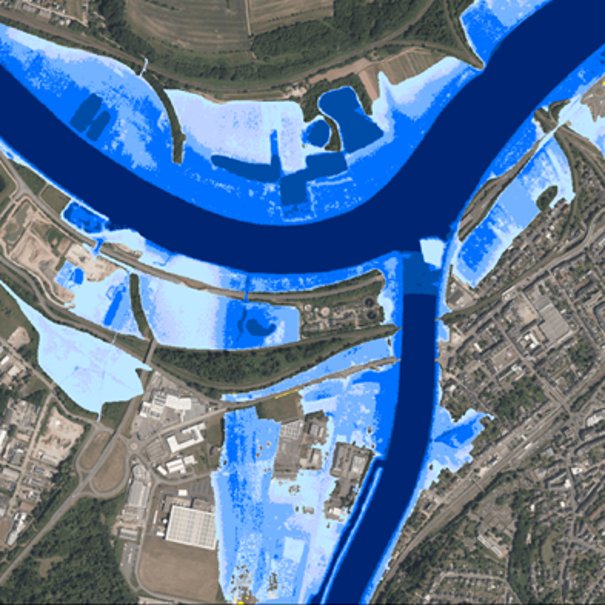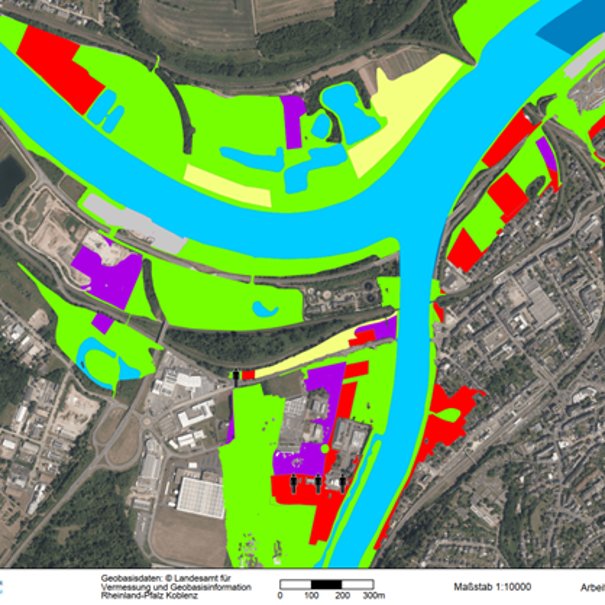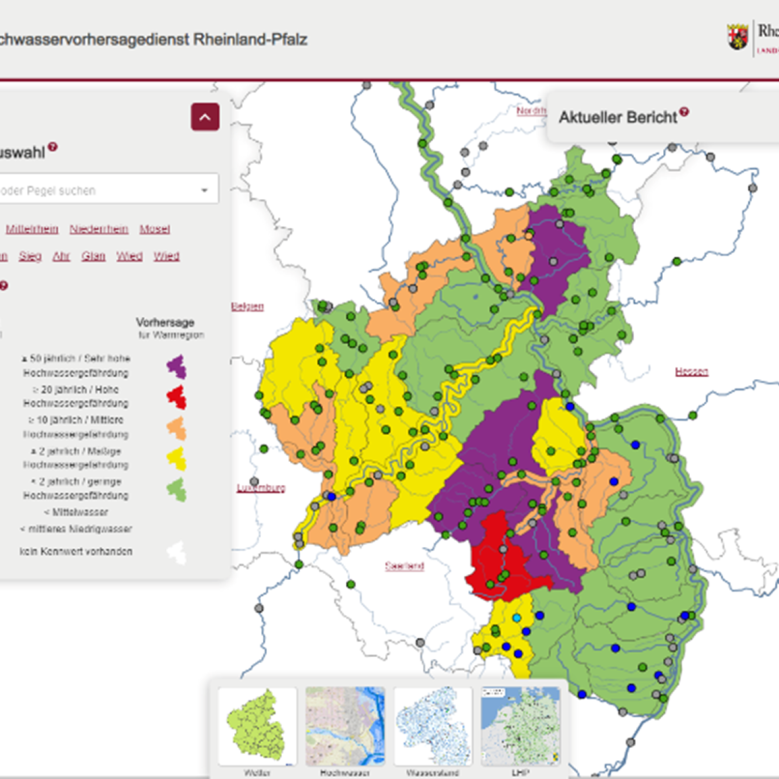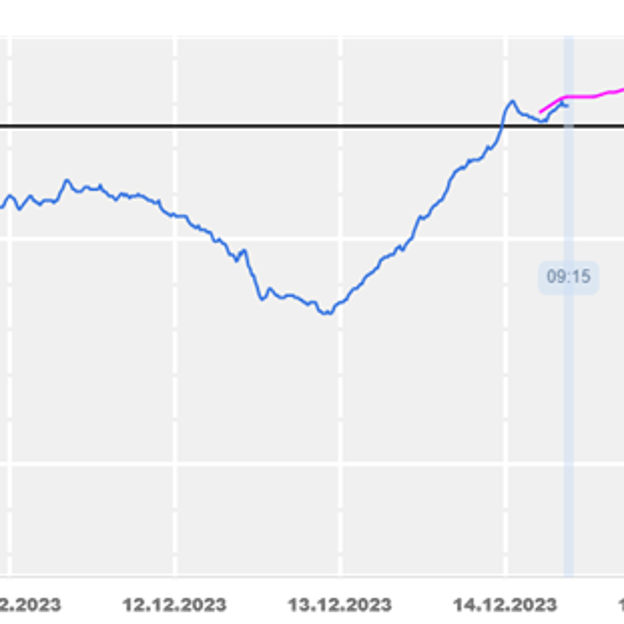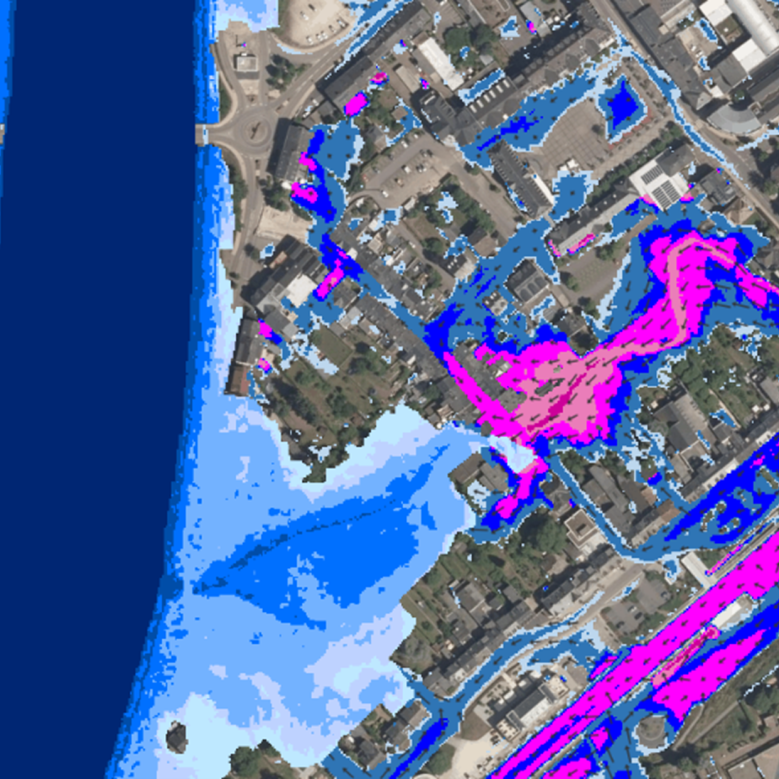Flood and heavy rain prevention
Located on the Moselle and Saar, there is a known risk of flooding from river floods within the Konz association of municipalities. Even in the local communities located only on smaller streams and water systems, intense heavy rain events cause damaging flooding, flooded basements and impassable roads. These dangers are intensified by flash floods from the outskirts, which pour from the vineyards and hillsides into the built-up areas and onto the connecting roads, where they have a considerable potential for damage. Measures to avert danger have already been taken in the Konz association of municipalities in the past. Due to the floods that have occurred more frequently in recent years, also in places remote from the Moselle and Saar, the need for targeted precautionary measures against heavy rain events and flash floods is increasing.
How do floods occur?
If there is prolonged and/or widespread rainfall, possibly accompanied by snowmelt in higher mountain areas, large amounts of water can flow into the Moselle and Saar. This can cause the rivers to swell and overflow their banks - this is then referred to as Flood The water can flood and undermine buildings, paths, bridges or dams, which can affect local infrastructure and pose a direct threat to those living along the river. Floating debris is particularly dangerous. Floods are natural phenomena. They occur at different heights and at irregular intervals. Floods have always existed and we must expect them at any time. Floods only become a catastrophe for people because they have built into areas at risk of flooding without considering the risk.
Am I affected?
In the event of flooding, it is important to be informed about your own risk situation and to know in advance how high the water will be. For the larger rivers in the country such as the Moselle and Saar, Flood hazard maps and flood risk maps that show what can happen up to extreme flood events. These can be found under hochwassermanagement.rlp-umwelt.de can be viewed.
Flood hazard maps, for example, provide information about the general risk of danger. You must take action if your building is located in a possible flood zone or if the flood exceeds the height of the existing protective structure.
Illustrations : Extracts from the flood hazard and flood risk maps of the state of Rhineland-Palatinate
Where can I get current flood information?
- On the Internet you can find hochwasser.rlp.de the flood forecast service of the state of Rhineland-Palatinate with current water levels and forecasts for the next 48 hours as well as the 24-hour forecast for the catchment areas of smaller rivers (early warning). For the Moselle, the Water level of Trier and for the Saar the Gauge of Fremersdorf important reference levels.
- The official water level and flood information app is available for smartphones My levels under hochwasserzentralen.info/meinepegel/ or the nationwide mobile flood reporting service KATWARN ( katwarn.de ). The Warning app NINA is another federal emergency information and news app.
- The information available on the Internet can also be found in the Teletext of SWR television on Table 802 .
- Finally, the current water level of a gauge can be determined via the national Phone number 19429 can be queried in the respective local network.
If you have no experience with flooding yourself, ask your neighbors who have experience with flooding; they can give you the most accurate information about what level will affect your house and property and how.
Illustrations: Example water levels of the Trier / Mosel gauge between 10 and 16 December 2023 ( hochwasser.rlp.de/flussgebiet/mosel/trier ).
And what about heavy rain?
As climate change progresses, the frequency and intensity of heavy rainfall events leading to local flooding (so-called Flash floods ). Such events are equally likely everywhere, meaning that everyone can be affected!
Since 2023, the state of Rhineland-Palatinate has been making publicly accessible flash flood hazard maps available via the LfU water portal at wasserportal.rlp-umwelt.de The maps show the water depths, flow speeds and flow directions of surface water runoff as a result of heavy rainfall events. Scenarios with different rainfall levels and durations are considered.
Use the available information on the risk from the flash flood hazard maps provided as well as the advice service set up in the Konz municipality on possible measures in the event of an impending flash flood.
Illustration: Extract from the flash flood hazard map of the state of Rhineland-Palatinate ( HERE ). Water levels and flow velocities during an exceptional heavy rainfall event (SRI 7) with a duration of D = 1 hour.
What is the difference between the potential dangers of flooding and heavy rain?
In contrast to flooding, flash floods can occur anywhere in Rhineland-Palatinate, regardless of whether streams or other flowing water are nearby. Even slight slopes encourage masses of water to flow onto buildings. In depressions and underpasses, precipitation can collect during torrential rain and the water level can rise quickly. While heavy rain events occur particularly during thunderstorms in the summer, the so-called Flood season mainly in the winter months.
While heavy rain events cannot be predicted precisely in terms of space and time, and therefore there is no time for the short-term implementation of protective measures, there is a certain lead time and reaction time for the flood events on the Saar and Moselle.
Regardless of whether you live in a particularly vulnerable flood area, there is a general risk of Backflow in the sewer system and the ingress of water and mud into your building, as the drainage channels are not designed for heavy rain events. In the event of flooding, there is also the risk of rising groundwater ( Groundwater flooding ), which can affect your building much earlier than the actual flooding. The previous owner or neighbors are best placed to give you information about this.
How can I protect my building from flooding?
There is no such thing as complete protection of buildings against every type of damage event. However, in many cases a higher level of protection and thus greater safety can be achieved with a reasonable amount of effort. In the case of a new building, the concerns of flood prevention can be taken into account within the framework of the structural self-provision be fully taken into account. However, protective measures can also be taken and structural changes made to existing buildings to prevent impending flooding and flood waves from flash floods and flooding caused by heavy rain runoff from entering the building. Depending on the type of building, construction, location and degree of risk, different property protection measures are possible. The following recommendations represent only a selection of possible protective measures.
First, we need to distinguish mobile and permanently installed protective devices The installation of mobile protective devices in the event of flooding is only relevant for buildings located in the flood plain of a river flood. For buildings in areas at risk of flash floods and on slopes, as well as for structures located in low points, hollows or below ground level, permanently installed devices are advisable.
Permanently installed protective devices
- When building a new house, make sure that it has enough weight to prevent it from floating. Also secure heating oil and gas tanks against floating.
- Install the electrical distribution and (gas) heating systems on upper floors and thus in flood-protected areas and ensure that all important consumers have an independent power supply.
- Doors, window elements and garage doors should be waterproof and shockproof against possible water pressure and debris carried on the outside. In addition, use water-repellent protective coatings and water-resistant building materials and components to minimize the potential for damage.
- Where possible, permanently close critical building openings. Lower-lying areas of the property, basement entrances, cellar and light shafts should be secured by installing thresholds, curbs, etc. In the case of a new building, you should raise entrance areas by at least 15 - 20 cm and plan garage entrances ascending.
- In the event of a risk, protect yourself against the inflow of surface water from the outside area by creating natural earthen embankments without, however, negatively affecting neighboring properties by changing or even increasing the water runoff.
- Cover gutters above light shafts to prevent dripping water from the roof from entering.
- Protect your house from sewer water ingress by installing a backflow prevention device or lifting system so that wastewater can still be drained away even in the event of water backflow.
- Depending on the extent of the problem, create a depression of approx. 30 x 30 cm ( Pump sump ) in the room at risk of flooding and have submersible pumps and an emergency power generator ready to pump out the water more effectively in the event of an incident.
Mobile systems
- Keep mobile flood protection materials (sandbags, dam beams) available for short-term installation at water-permeable building openings.
- Silicone or waterproof plywood can also be used to temporarily seal doors and windows.
How should I behave before a flood event?
- Keep important documents and personal items safe, for example in waterproof containers. Store substances that are hazardous to health and the environment outside the flood-prone area.
- Do not store movable objects on the property you are using, or secure them sufficiently and securely - especially if you live near a body of water. Larger objects such as garden furniture, vehicles, hay and silage bales, rain barrels, etc. pose a particular risk to you and those living downstream. Loose building materials, stacks of firewood and green waste should be stored and secured at a sufficient distance from bodies of water, as they can be carried away if the water overflows and lead to blockages on bridges and other narrow places, which further exacerbates the flooding situation due to backwater.
- Insure your building and household contents, as damage can occur despite state and private precautionary measures, and seek advice on the options and conditions for taking out natural hazard insurance against flood damage to the building.
- Check the sewer in the house regularly.
- Make arrangements with your neighbors about possible mutual support.
- Follow the weather forecasts of the German Weather Service ( dwd.de ) and reports from regional programs as well as current flood warnings regularly.
How does the municipality help me protect myself from flooding?
In Germany, every person who can be affected by flooding is obliged to take suitable precautionary measures to protect themselves against the adverse effects of flooding and to minimize damage within the scope of what is possible and reasonable. Only when measures to protect the general public against floods become necessary, i.e. when there is frequent material damage to an extraordinary extent among a larger number of people affected, does there exist an overriding public interest in flood protection. Then the cities and municipalities, the districts and the state are responsible.
Further information about this service can be found HERE can be retrieved.
The increasing importance of the issue prompted the Konz municipality to draw up a local flood and heavy rain prevention plan (öHSVK) for the local communities in the municipality's area and for the city of Konz. The aim is to define measures that will help improve prevention and are to be implemented gradually. Information on the progress of the implementation of the öHSVK can be found on the following page:
